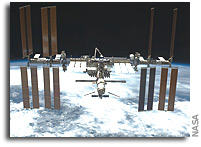NASA International Space Station Lead Increment Scientist’s Highlights, Final Weeks of March 2011

(Highlights: Final Weeks of March 2011) — The Boiling Experiment Facility (BXF) was successfully installed into the Microgravity Science Glovebox. The facility is being used to conduct two experiments: the Microheater Array Boiling Experiment, or BXF-MABE, and the Nucleate Pool Boiling experiment , or BXF-NPBX. BXF-MABE has successfully conducted 184 test points so far. This investigation determines the critical heat flux during boiling in microgravity to design optimal cooling systems for future space exploration vehicles as well as on Earth.
Two crew members completed nominal runs with the Psychomotor Vigilance Self Test, or Reaction Self Test. The experiment is a portable five-minute reaction time task that allows crew members to monitor the daily effects of fatigue on performance while aboard the station.
Cady Coleman completed her fourth session with the Nutritional Status Assessment, or Nutrition. This comprehensive in-flight study is designed to understand changes in human physiology during long-duration spaceflight. This study includes measurements of bone metabolism, oxidative damage, and chemical and hormonal changes; as well as assessments of the nutritional status of the crew members participating in the study. The results have an impact on the definition of nutritional requirements and development of food systems for future space exploration missions.
Crew members completed pill ingestion for Bisphosphonates as a Countermeasure to Space Flight Induced Bone Loss, or Bisphosphonates. The purpose of this investigation is to determine whether bisphosphonates, in conjunction with the routine in-flight exercise program, will protect crew members from the regional decreases in bone mineral density documented on previous space station flights.
Coleman made successful contact with Lehman High School in Kyle, Texas as part of the International Space Station HAM Radio experiment, or ISS HAM Radio. By utilizing ham radios, this experiment gets students interested in space exploration by allowing them to talk directly with the crews living and working aboard the space station.
The Hyperspectral Imager for the Coastal Ocean, or HREP-HICO, Experiment Payload has taken 2,796 images to date, including recent images of Panama City, Fla., the coast of North Carolina, part of the English Channel and the coast of Japan near Sendai. The experiment analyzes the water clarity, chlorophyll content, water depth and ocean or sea floor composition for naval purposes.
The Remote Atmospheric and Ionospheric Detection System, or HREP-RAIDS, is collecting secondary science including nighttime atmospheric disk photometry, spectra and temperatures. RAIDS provides density, composition, temperature and electron density profiles at altitudes between 95 and 300 kilometers.
Coleman completed her first blood collection and processing session for the Canadian Space Agency’s Vascular Health Consequences of Long-Duration Space Flight, or Vascular, experiment. Vascular investigates the impact of long-duration space flight on the blood vessels of astronauts.
The Japan Aerospace Exploration Agency’s Production of High Performance Nanomaterials in Microgravity, Nanoskeleton-2, crystal growth experiment was conducted from March 29 to April 1. Nanoskeleton-2 aims to clarify the effect of gravity on oil flotation, sedimentation and convection on crystals generated in microgravity.
Vic Cooley, Lead Increment Scientist Expedition 27/28








